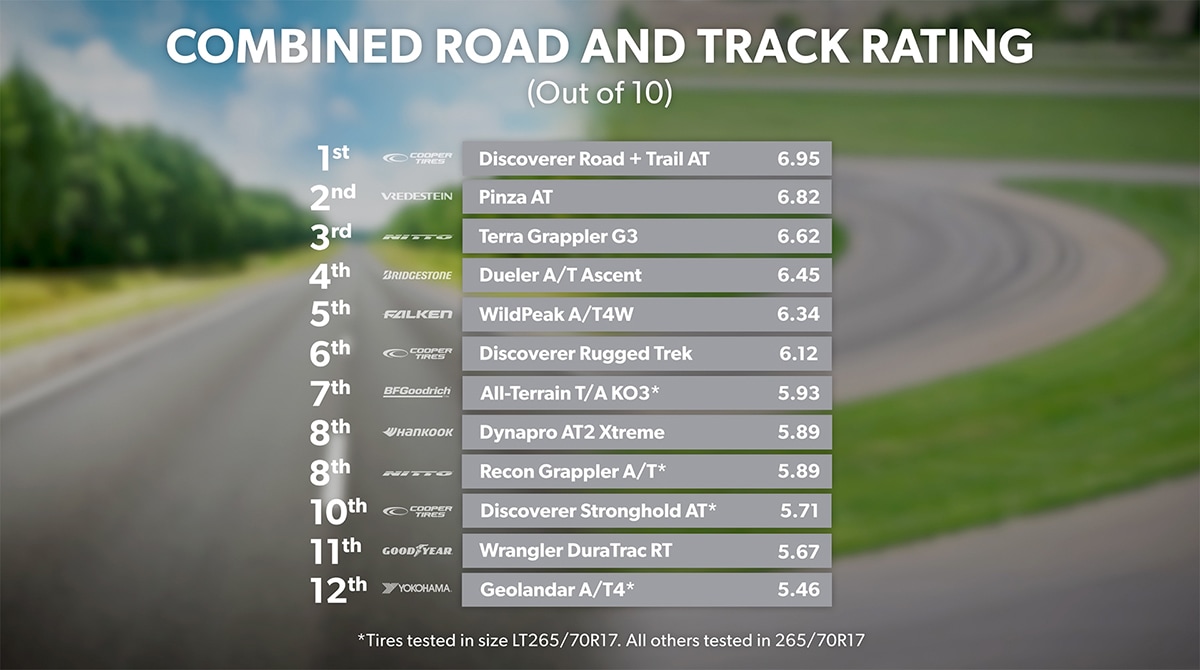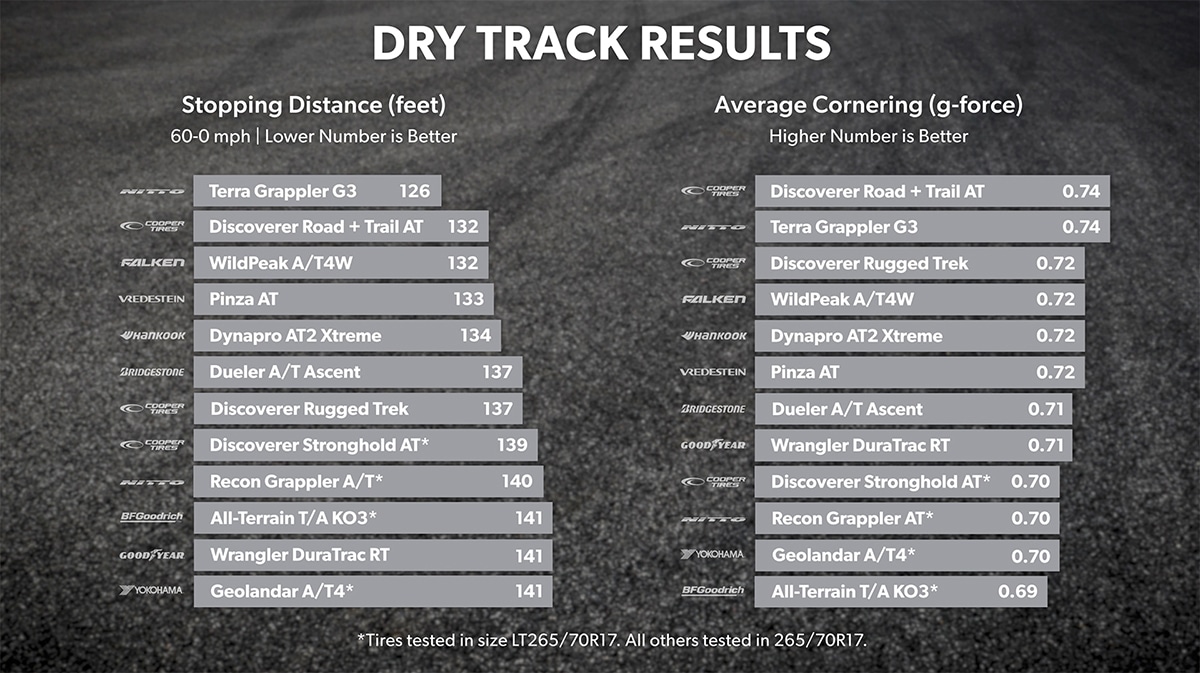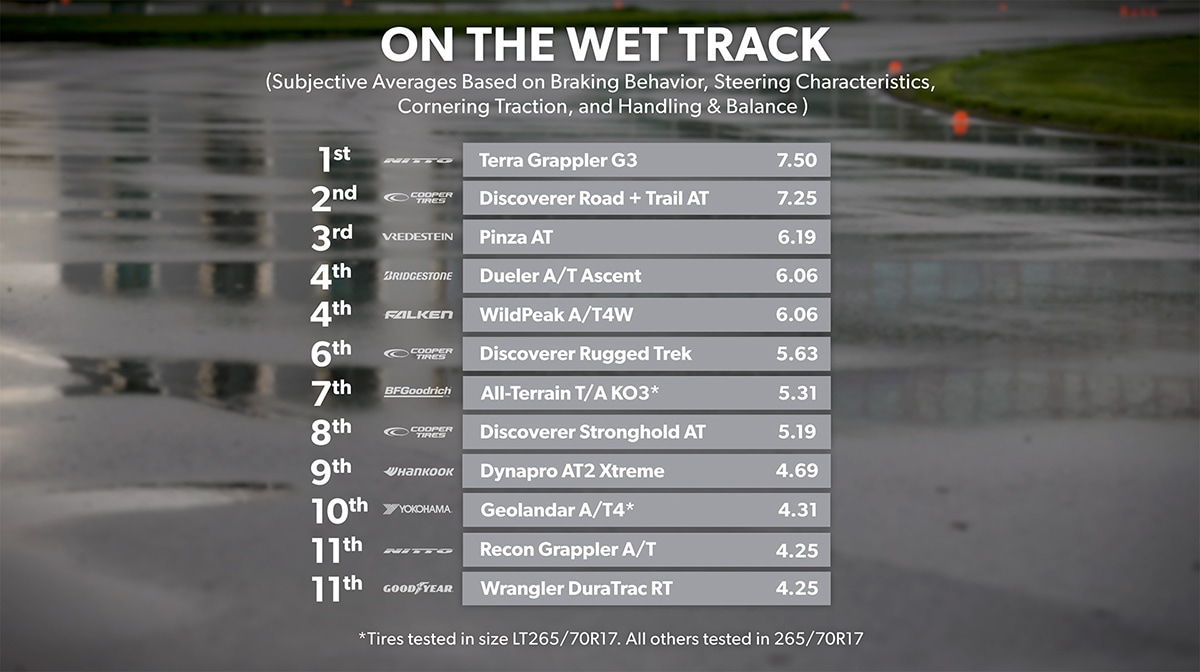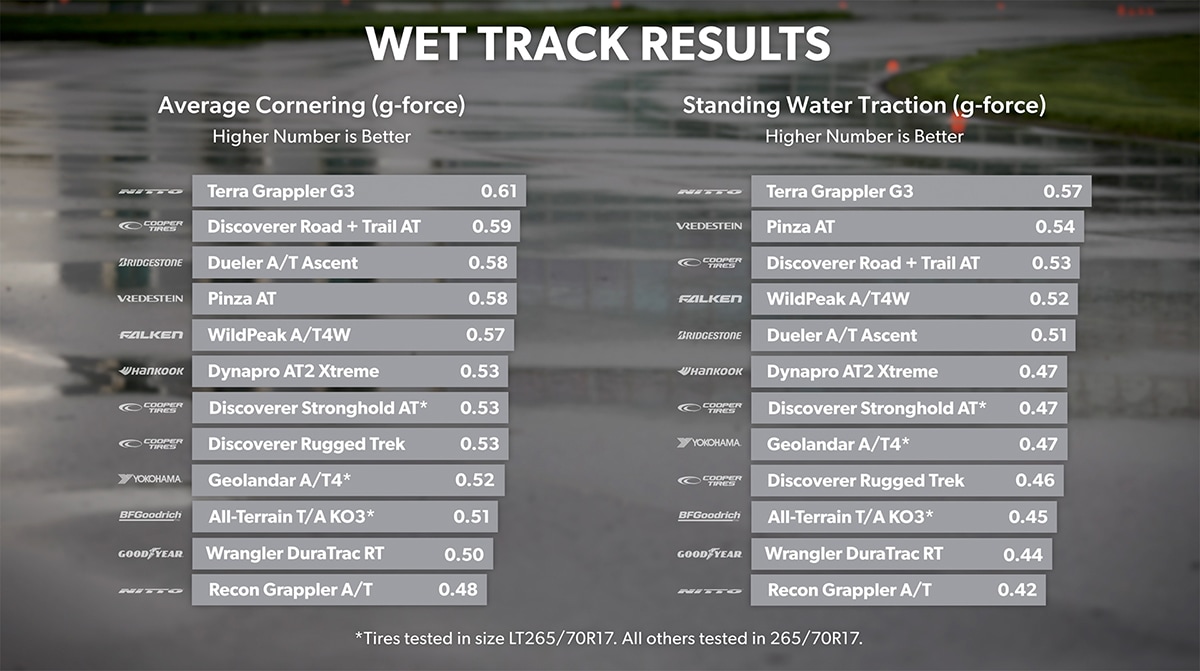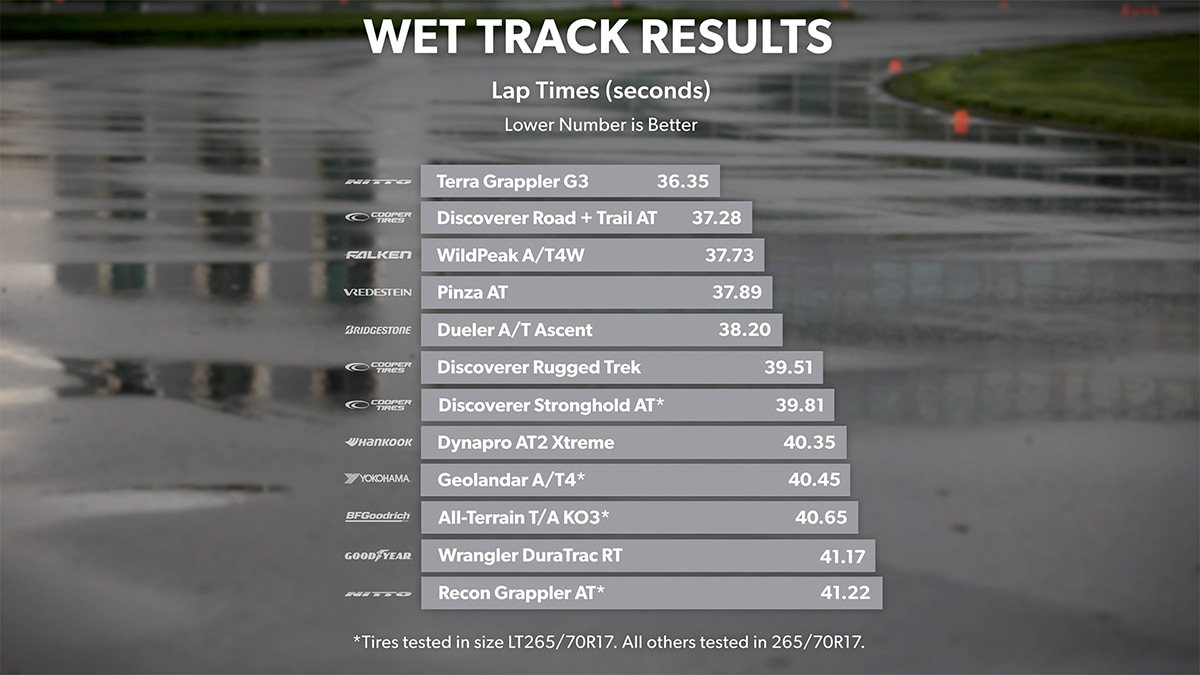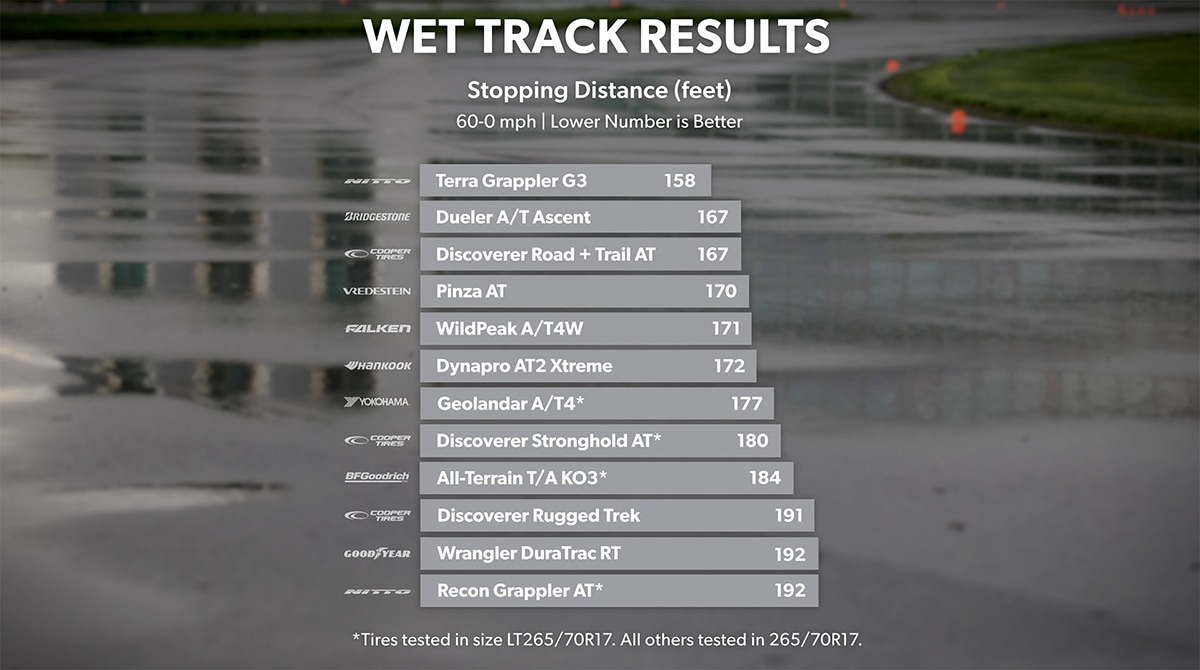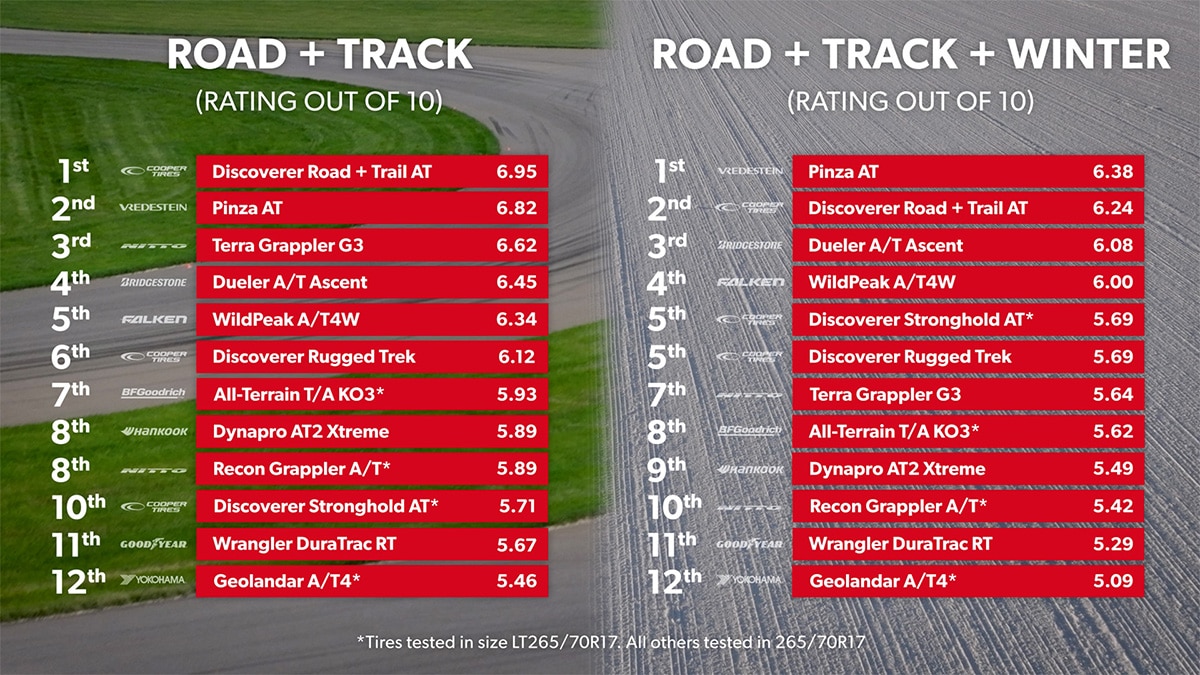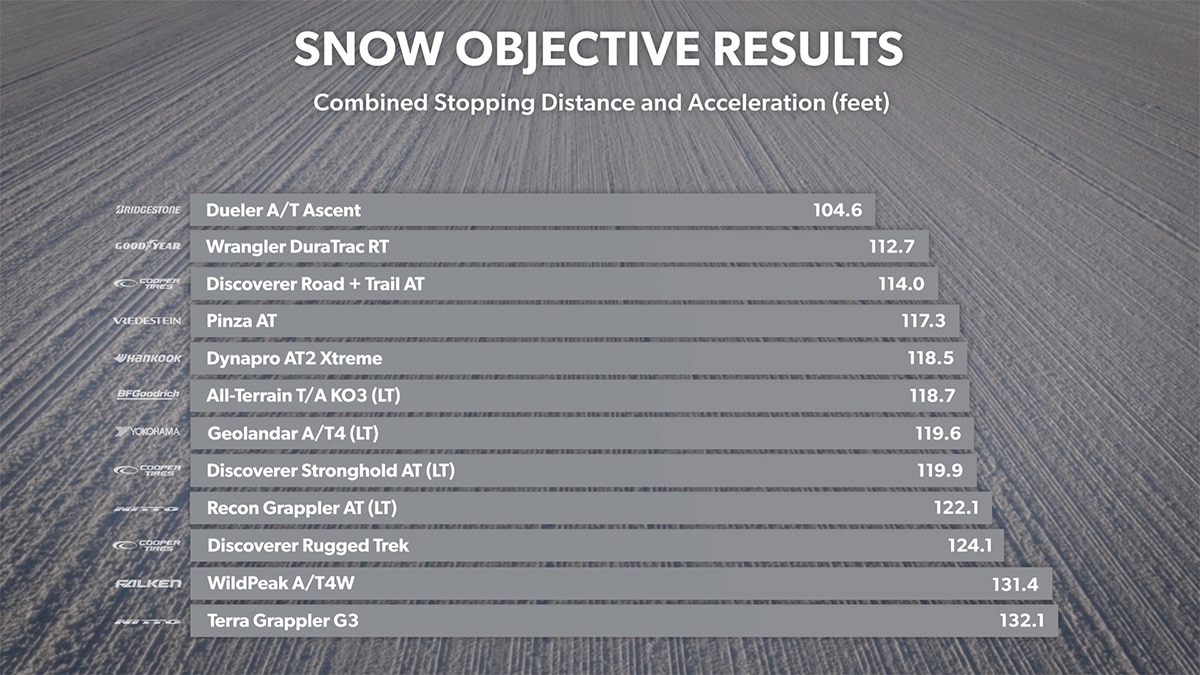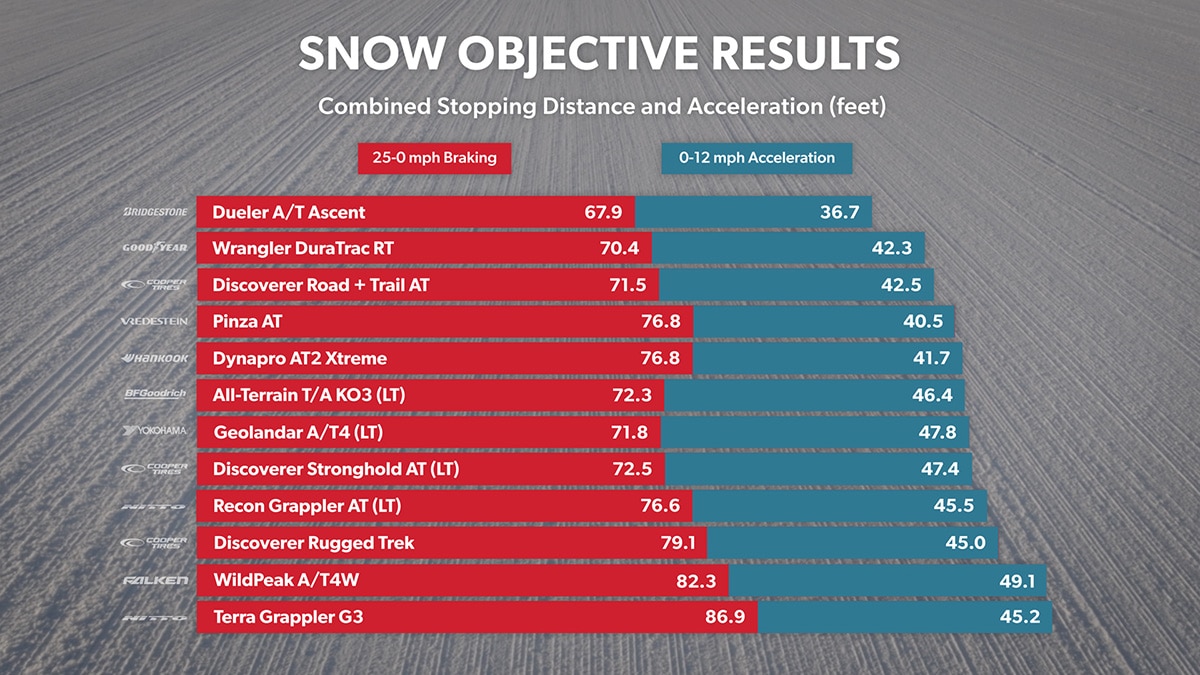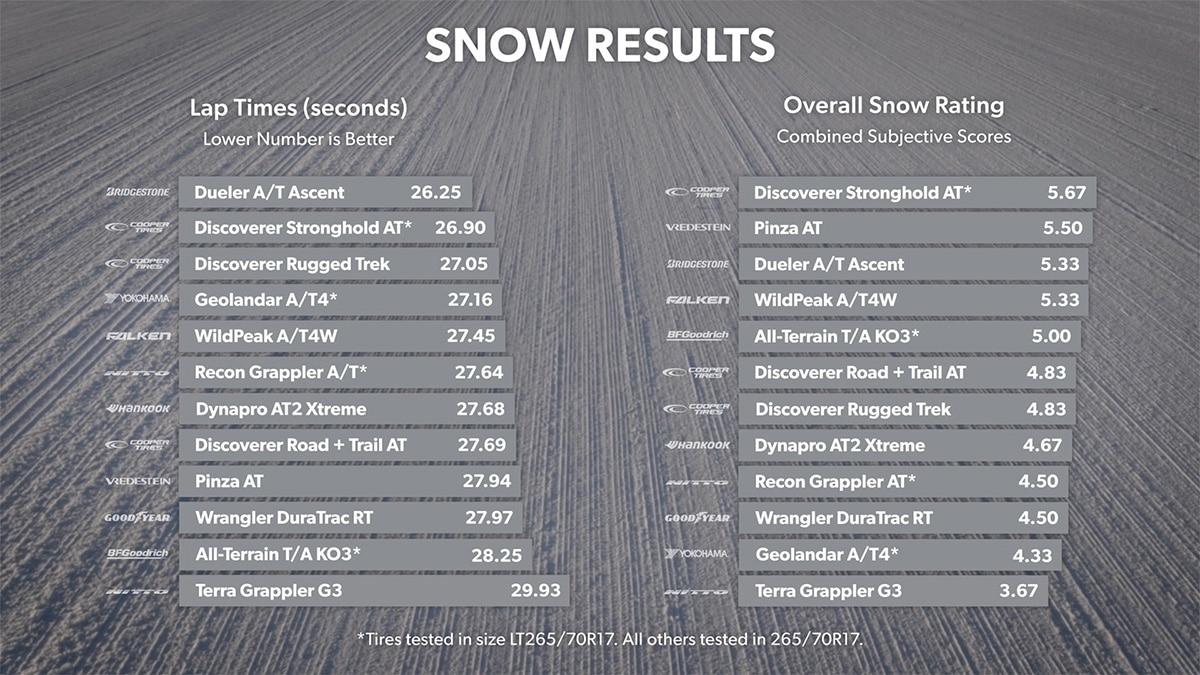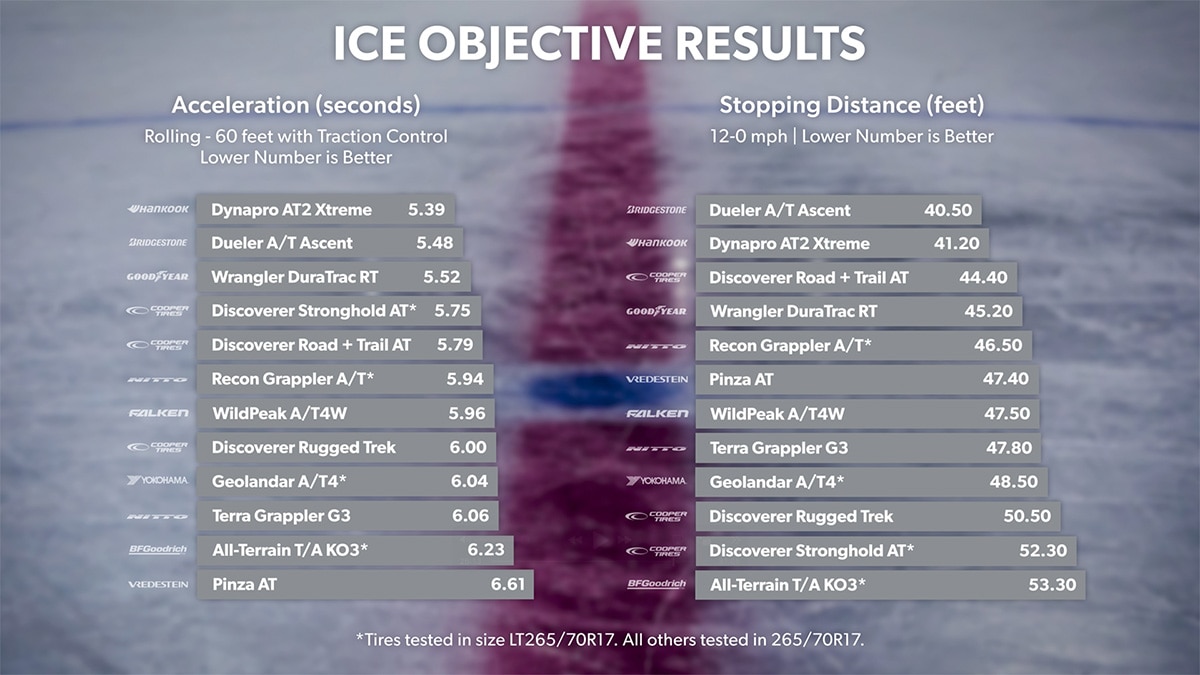There's no getting around it: "All-Terrain" is wide-ranging; as a term, as a categorical umbrella, it encompasses several different types of vehicles, tires, and yes, terrains. Often with wildly different, and even conflicting, purposes and needs. If there's one consistent feature in tires, as with life, specialization involves sacrifice - the same features and technology that favor better traction in mud aren't necessarily ideal for snow, or wet roads. Without breaking down every category, the greater into the extremes one goes, the more trade-offs one can expect. Inversely, the more a tire is designed to do a little bit of everything, the less focus can be spent on making it really good at any one job.
This is all broad strokes, of course, once you drill down to the category level there is a lot of nuance between individual tires where one might score more marginal advantages over another. It is in exploring exactly these nuances where testing comes in - and this is one of the biggest we've done yet. Three different categories, twelve separate tires, and one 2024 Toyota Tacoma. We'll be looking at On-Road All-Terrain, Off-Road All-Terrain and Rugged All-Terrain tires. On-Road and Off-Road are fairly self-explanatory: they're both All-Terrain categories with their specific focus right in the name. Rugged All-Terrain tires are a little more difficult to quantify - if they have one unifying principle, it's that they carry an aggressive off-road aesthetic more intense than you'll find in either of the other two categories. Many tires in this category do have off-road performance that falls in-between a traditional All-Terrain tire and an Off-Road Max Traction (or Mud) tire. While that performance isn't guaranteed, they'll certainly look the part.
As one of the largest tests yet, we'll be diving right into each tire's experience with no preamble. Since the main focus of the test is the reality of living with these tires on a daily basis, in addition to our real world road ride, we'll be evaluating aspects of general safety with a 60-0 mph braking test, checking dynamic maneuvers on a wet track and performing our Emergency Lane Change on a dry surface to see how these tires handle situations that mimic real emergency driving.
Winter driving for these tires was evaluated in packed snow, with acceleration and braking in a straight line followed by 32 mph S-turn maneuvers to check both their objective strength in those areas, and their composure. Did they squirm? Slide? Spin? Each tire was taken through a snow-packed circle to evaluate lateral loaded behavior, as well as a simulated "off-ramp" maneuver mimicking a common highway situation drivers have to deal with. Ice braking and acceleration are also handled in an environmentally controlled indoor facility to test the tires' braking distances from 12 mph and time-to-accelerate on the ice.
We'll start with the On-Road All-Terrain tires and get more "rugged" as we go.
Bridgestone Dueler A/T Ascent
Road Ride: In a word: "firm." Larger impacts were noticeable, but mostly cushioned. Small, repetitive motion was transmitted directly enough to shake our testers' bodies, however. There was persistent roar from tread interaction over the initial crosscut concrete that remained through the majority of the ride and rose in volume at highway speeds, occasionally joined in concert by tones over other surfaces. Notably a warble on the smoothest roads, and a coarse, hollow grind over chip and seal. Volume-wise, it was reasonable for the category overall. The steering feel was somewhat mixed: it felt good on-center at higher speeds, and responsive when given direction otherwise, but took more input at lower speeds.
Wet Track: The Dueler A/T Ascent was an interesting tire to drive on a wet surface. The steering wasn't particularly eager or happy to comply with big inputs. Given enough time and distance to adjust brake zones, it could be saved from understeering through a turn, but it would still step out at the rear. Essentially, one of the two axles wasn't going to behave, and it was up to the driver to decide which one.
Dry Characteristics/Emergency Lane Change: It struggled to complete the ELC maneuver, and failed more often than it succeeded. The steering felt delayed; there was a slight moment between turning the wheel and getting a response that made reacting to momentary changes more difficult. Too much speed or any added hesitation on inputs, and it wouldn't clear the lane change. If it transitioned into understeer, there was little that could be done to recover it.
Winter: In pure objective measurements, this was the strongest tire we tested in the snow, nothing else was close. The shortest braking, quickest acceleration, it was handily the best out there. It made good use of its traction as well, with quick steering, and a mostly balanced feel overall. That did work both to the tire's benefit and detriment - typically if it broke traction, it was an all-wheel affair. During the off-ramp, it could be easily directed with the front axle, even loaded into the turn and near the grip limit. When trying to make adjustments mid-turn, lifting off and reapplying the throttle wasn't effective, but braking tucked the nose in nicely. Ice traction was just as laudable, with test-leading braking and acceleration, the Dueler A/T Ascent came to a stop at just over 40 feet.
Cooper Discoverer Road+Trail AT
Road Ride: The ride was pleasant, cushioning large impacts nicely and handling the smaller ones with little, if any excess movement. Noise was well-managed for this category too - some roar from the crosscut concrete that fell away significantly over asphalt, joined by low volume warbles over the smoothest surfaces, but generally most tones faded into a uniform blend of white noise. The steering was commendable also, with little that stood out as problematic or annoying.
Wet Track: It was capable and responsive when faced with the lowered traction of the wet track. The steering was alert and accurate, even if it lacked much in the way of feel or heft. Traction felt, across the board, like a step up compared to the entire test group, with more available grip in corners, or even correcting small mistakes. Braking felt more dependable, more authoritative.
Dry Characteristics/Emergency Lane Change: The Discoverer Road+Trail AT was able to confidently clear the maneuver almost every time. With less steering input needed, side-to-side moves were more controlled, which helped significantly. As with most of these tires, it would still push into understeer, but the responsive steering helped usefully point the vehicle in time to keep it from being a damning issue.
Winter: Braking and acceleration figures in the snow were decent. If that were the only evaluation, it was competitive with the best tires in the test - but in practice it required sensitive application of the throttle, and felt much weaker laterally, belying a lack of traction holistically. It was still planted and stable under the limit, but it could be edgy beyond that point and recovery was not quick. The off-ramp was a commitment, because any input other than braking was largely ineffective. Ice braking was among the stronger tires tested, at only 4 feet apart from the test leader.
Hankook Dynapro AT2 Xtreme
Road Ride: The overall ride leaned toward firm, but it was able to round over most larger impacts, even if some were a bit sharper. The smaller bumps and undulations were muted, but additional up-and-down movement was still noticeable, including at highway speeds. The noise floor was higher on average over the entirety of the ride, with tonal variety all over - there was more noticeable warbling over the multiple portions of asphalt road, loud tread slap over tar strips, and a high-pitched tone on smoother surfaces. Steering on the Dynapro AT2 Xtreme felt decent at higher speeds, although more vague, and not as securely on-center as most other tires here, it was quick to respond. Though at lower speeds, it felt like it took more steering input than was natural to get an appropriate response.
Wet Track: The Dynapro AT2 Xtreme surprisingly managed to make driving on a wet track feel more slippery than usual. Traction was the first and most obvious issue, with a significant early lead required to even begin slowing down the truck. Entering a corner or otherwise maneuvering the truck required that all braking be completely finished beforehand, because trying to steer and brake was a recipe for losing useful control of the vehicle. Even significantly slowed, it could understeer mid-corner. Adding throttle would spin up the rear tires or step out the rear axle. Any kind of emergency on the road would need ample lead-time to slow down and respond.
Dry Characteristics/Emergency Lane Change: Mercifully, it was much more manageable on a dry surface, though clearly traction was still an issue, as it had a tendency to spin the rear tires a little easier than we preferred with aggressive throttle inputs. The steering was responsive enough to direct the nose before pushing into understeer, but it wasn't eager to recover from that state either. It passed the Emergency Lane Change most of the time, but each attempt felt like a narrow escape rather than secure and controlled.
Winter: The Dynapro AT2 Xtreme displayed reasonable straight-line ability. It didn't stand out objectively, but its lack of poise was noticeable - steering was non-linear, and the overall experience didn't feel as strongly planted or balanced as other tires. The rear of the truck really wanted to come out, and when it did, recovery was slow. On the off-ramp, adding steering was ineffective, and light braking made it want to rotate. It was notably the 2nd strongest tire on the ice however, at just over 41 feet to come to a stop.
Nitto Terra Grappler G3
Road Ride: The tires handled large bumps with reasonable cushioning, although the final bit of travel was uncomfortably pointed. Ironically, it was the smaller bumps and undulations that posed the most issue, turning the uneven elements of the street into a consistent jiggle. Noise control was all over, creating a variety of tones in different environments, many of them notable for being higher in tone and more insistent than just errant sounds. The steering felt loose and vague, not terrible, but not worth getting excited over either.
Wet Track: Whatever it lacked on the road, the Terra Grappler G3 made up in the wet. The steering was responsive, pointy and among our favorites in the test. Braking felt like a significant improvement over almost all of the other tires tested, which was critical, because the tires found enough acceleration traction to provide a challenge. Lateral traction was also strong, and combined with its other characteristics, allowed our drivers to manage slalom driving or the skid pad without much worry from spinning the rears or having them step out unexpectedly.
Dry Characteristics/Emergency Lane Change: There was little not to like during the dry portion of the test either. Steering felt responsive and hefty, and its braking was strong. As with most of these AT tires, it could still push into understeer, but not as quickly compared as much of its competition. The Emergency Lane Change posed little problem for the Terra Grappler G3 and it cleared the maneuver nearly every time.
Winter: Unfortunately, the positive energy built up by the Terra Grappler G3 in the wet and dry did not carry over to its cold-weather driving. Snow braking was, objectively and subjectively, the weakest we tested at just under 87 feet to stop from 25mph, a full 19 feet further than the best. Acceleration wasn't much better, and while not numerically the worst (it was close), it required ginger throttle application to use, and the traction control still kicked in regularly. Naturally, the rest of the testing followed suit, with it simply being sensitive everywhere, pushing wide or stepping the rear out with too much throttle or steering in nearly every situation. Even the off-ramp needed to be managed at a slower speed than usual. Ice braking was neither spectacularly bad or good, but it was near the back of the class there too, with over 47 feet to come to a stop.
Vredestein Pinza AT
Road Ride: A comfortable, well-controlled ride with generally low noise across concrete and asphalt surfaces. While the smooth surface revealed cyclical pattern noise, it remained unobtrusive. The ride quality was composed, and the noise was steady and mid-level, showing low growls on bypass roads that diminished on asphalt. Steering performance was adequate, though not especially remarkable; it avoided any negative habits and was simply effective.
Wet Track: It struggled to put down power consistently, resulting in occasional rear-end slippage. It tended toward understeer, as most of these tires did. Steering response felt slightly delayed, even when traction was adequate, which limited confidence. Overall, it was functional but underwhelming, lacking in precision and engagement and yet, it was still one of the better performing tires on the wet track among this test as a whole.
Dry Characteristics/Emergency Lane Change: It managed Emergency Lane Changes most of the time, though speeds had to be carefully managed to avoid overwhelming the front end. As with most tires here, it could push into understeer, but it felt recoverable, and still somewhat responsive even while understeering. Steering response was, in general, reasonably good, offering crisp directional control after an initial delay.
Winter: Plainly put, it just felt nice in the snow. Objectively, it was 2nd best in acceleration, and not bad in braking (middle of the pack), but it was the overall experience that left a positive impression. Front and rear were balanced. Steering was quick and directed the front end nicely. It felt like approaching the limit had some grace before letting go. When it was over the limit, it was still easy to control, wanting to stay straight ahead rather than spin or stay sideways. It was weaker braking on the ice, taking 7 feet further than the best to come to a stop, but still a good overall showing.
Yokohama Geolandar A/T4 (LT)
Road Ride: A significantly firm, but composed ride, it muted sharp impact peaks reasonably well though it exhibited noticeable vertical movement over bumps and undulations. Noise levels were consistently high everywhere, with a distinct tread interaction across every surface. Sound persisted across various surfaces without any real reduction in volume. It was, to put it plainly, just loud. The steering was generally fine, nothing that stood out as extraordinarily good or bad, but it tended toward loose and vague, and felt less planted at highway speeds.
Wet Track: Bluntly, this was a poor experience. Braking was particularly weak, causing the Anti-Lock Brake System (ABS) to engage erratically, resulting in unpredictable jolts down the track. The steering felt vague and disconnected, rapidly losing grip and requiring constant adjustments at the wheel. Rear traction was minimal, leading to rear-end instability. This low level of control made for an exasperatingly slow, challenging drive.
Dry Characteristics/Emergency Lane Change: Not quite as underwhelming as it was in the wet, but steering was still notably sluggish and lateral traction was minimal during the Emergency Lane Change. It would respond initially, but then lagged significantly, behaving more like a slow, controlled "hockey stop" than an agile maneuver. While it technically completed the task, the experience felt off due to substantial understeer and significant speed scrubbing. Braking also fell short, and the delayed response on direction changes made it feel awkward, ultimately detracting from its handling performance.
Winter: Acceleration was immediately an issue - with one exception, the Geolandar A/T4 struggled more than almost any other tire to find grip in the snow, it just wanted to spin, even with the softest application of throttle. Braking was a bit more confident, taking nearly 72 feet to come a stop from 25mph. Turning felt good initially, confidently directing the nose with the front, but any quick movements would result in trouble. Treated slowly, gently at every step of the way, it could get up to speed and glide around. Even above the limit it was easy to control, but it took effort. Ice braking was toward the back of the pack - there were 3 other tires that took further to stop, but 48.5 feet from 12mph wasn't encouraging either.
Now we get into the Off-Road All-Terrain options. Generally, these tires will sacrifice more on-road comfort for off-road capability, but can still be counted on to maintain a balance between both for the times they'll be counted on for day-to-day travel.
BFGoodrich All-Terrain T/A KO3 (LT)
Road Ride: The tire exhibited a firm, controlled ride that managed to dull the more pointed impacts, but was largely unremarkable. There were distinct, layered tones that blended well at highway speeds but were more noticeable on smoother surfaces. On coarser asphalt, the noise evened out, blending into the other tones, but switching back to smooth pavement, there was a subtle hum that remained audible. It responded quickly to steering input with minimal delay, offering an experience that felt almost 1:1, with the motion of the wheel translating fully, immediately to the motion of the vehicle. It was both light and accurate, though feedback was only moderate in corners.
Wet Track: The All-Terrain T/A KO3 felt largely adequate - in a subjective sense - with decent front-end sharpness and communication. However, when it came to actual performance, it just fell short, with slow response times, extended braking, and limited lateral grip. It felt confidently in control, especially at lower speeds, but was quickly overwhelmed at higher speeds. Power delivery lacked confidence, leading to a generally underwhelming driving experience that felt better than it was.
Dry Characteristics/Emergency Lane Change: It really struggled with stability and precision in the lane-change maneuver. It would start off feeling fine, and then the front-end traction was gone. Attempts to change direction led to understeer and even rear-end instability at times. The whole experience was marked by persistent understeer and a lack of stability, with only minor responsiveness in the front end that failed to inspire confidence. It felt unpredictable and ultimately never made a successful lane change attempt.
Winter: In the snow, it was a little sensitive to throttle, but not terribly so. Braking was reasonable, at just over 72 feet from 25mph. Steering was quick to respond, moving the front end with eagerness, if not athleticism. It was nice to drive around the circle, with only the occasional drift, and rarely pushed, for a more oversteer-biased approach. When it reached its limit on the off-ramp, more steering only made the tires push wider, and applying even light braking made for a full, slow rotation. The limits were edgy, easy to step over, which could be a bit unfriendly. Ice braking was the worst in the test, at over 53 feet to come to a stop from 12 mph. Still, a reasonable showing overall.
Cooper Discoverer Stronghold AT (LT)
Road Ride: The ride was stiff, with a significant amount of secondary movement over bumps, uneven road, patches and other imperfections. Noise levels were consistent but with noticeably higher volume compared to the On-Road All-Terrain tires on most surfaces, producing a blend of sounds. This included a prominent tone on concrete that developed into a layered, intrusive noise profile at highway speeds and was even somewhat intrusive returning to asphalt. It was relatively manageable on coarse surfaces but still loud both on smooth roads and chip and seal. Steering was responsive and direct, offering solid control on par with the better options tested.
Wet Track: This tire's performance was serviceable, if not exceptional, providing a reasonable amount of lateral traction. Grip across the board, braking included, was generally only adequate. While the steering was responsive enough to keep control, it didn't quite feel locked down, authoritative. Power delivery fell within the same range of "better than some, but not quite good." That was the story overall: decent, but well short of outstanding.
Dry Characteristics/Emergency Lane Change: Despite limitations arising from understeer and slower transitions, it remained controlled and steady. It was a bit sensitive to aggressive inputs, so a calm, steady hand helped here. At moderate speeds, it performed well, and felt like it at least resisted giving up. Traction wasn't exceptional, but it was adequate, providing a solid attempt at balanced handling within its limitations. For a heavier-duty all-terrain option, it did well, making successful attempts at Emergency Lane Changes around half of the time.
Winter: In terms of objective acceleration and deceleration in the snow, the Discoverer Stronghold AT was decent, requiring a little care to keep the traction control from kicking in, but good overall. However, this was a case where hard numbers really don't tell the full story. The authoritative steering was urgent, commanding, leading with the front-axle and not letting the rear step out of line, even while carrying speed around the circle. During the off-ramp, the front tires would still provide direction, even when loaded up or drifting over the limit. It kept our driver impressively in-control the whole time, under, at, and past the limit. Ice braking was on the weaker side, at just over 52 feet to come to a stop, but the trade-off for confident control in the snow is a strong argument.
Falken WildPeak A/T4W
Road Ride: A firm ride overall, and while movement in the cabin was noticeable it wasn't overly disruptive. Noise was very well-blended, particularly for the category. It was present, of course, but steady volume, offering a consistent low-level "whoosh" and controlled roar on coarser surfaces. The noise remained well-managed on most surfaces, with little beyond background noise, and expected outliers like tread slap over tar strips. Steering was responsive with moderate precision, showing no pronounced dead spot.
Wet Track: Steering was adequately responsive, not too quick for the available grip. It could have benefited from a little more urgency, but it wasn't bad. Lateral traction proved to be stable, generally maintaining its line without too much rear-end instability though it still tended to spin up more than ideal. The tires felt generally balanced - longitudinal and lateral grip were well-matched, delivering steady handling and braking feel that was, in a word: "fine". It wasn't the grippiest tire in this test, but importantly, performance was consistent across maneuvers, providing a reliable, balanced experience for an all-terrain setup.
Dry Characteristics/Emergency Lane Change: Once again: balanced, predictable performance, steering remained alert and responsive. Consistent traction and handling across lane-change exercises with solid results each time. While it didn't have the highest level of outright grip, it performed well enough to clear the Emergency Lane Change regularly.
Winter: It would spin during acceleration attempts, resulting in occasional traction control intervention, but with reasonable throttle application, smooth acceleration was definitely achievable. It wasn't particularly quick or strong longitudinally, with the furthest distance to reach target acceleration in the test and the 2nd furthest braking distance in the snow at just over 82 feet from 25 mph. Still, the steering felt decent, even if we'd have preferred a heftier, pointier experience, it was a nice tire to control. Front and rear axles worked in unison, making it easy to navigate the circle. During the off-ramp, understeer was prevalent, and while careful throttle application could tuck the nose effectively, light braking rotated the whole vehicle. It was tough to keep it controlled over the limit. Ice braking was also merely decent - 47.5 feet from 12 mph.
Nitto Recon Grappler A/T (LT)
Road Ride: A firm but reasonably well-mannered ride, handling bumps and cracks with a bit of stiffness but absorbing most other minor imperfections with little disturbance. Noise levels were very nicely controlled for the category, with steady, blended, unobtrusive tones on various surfaces, though our testers still caught tread slap and a slight warble over asphalt around 40 mph. It was still one of the nicest in the test, even compared to dedicated on-road options. Steering too, was responsive and linear with minimal dead zone, making it quick off-center.
Wet Track: The Recon Grappler A/T struggled mightily with nearly every aspect of wet driving. Steering initially felt responsive but it would saturate and quickly just give up, reaching its limits, resulting in persistent understeer, with any kind of weight shift only worsening control. The tire consistently pushed all four wheels in sweeping arcs, impacting lap times and creating the kind of directionless scenario that might alarm less experienced drivers on the street. Quick or stable handling proved almost impossible, and although drifting was achievable, that was hardly useful. It just, plainly, lacked the essential grip needed for balanced control and confident maneuvering.
Dry Characteristics/Emergency Lane Change: Initial steering responsiveness was decent, but once it transitioned into understeer, it struggled to recover quickly. In the Emergency Lane Change, the first part of the maneuver was fine, but on the return swerve, it would resist, slowing down to the point that it could clear the 3rd gate. As it lost speed, the understeer that was delaying steering response felt like it would let up very abruptly, requiring very quick correction to keep it in the right direction. It still managed a 75% success rate, but it wasn't clean or dignified pulling it off.
Winter: In the snow, acceleration was a bit of a step down from the group's baseline, not terrible, but not quite good. Braking was similarly a struggle, taking over 76 feet to come to a stop in the snow from 25 mph. As long as it was under the limit, steering felt particularly good: pointy, direct, and fast. Driving around the circle, front axle traction was decent, but the rear was particularly sensitive to throttle input and would step out first. The off-ramp experience was vexed by understeer, braking and lift off throttle application only made it worse - any further throttle would just make it pop sideways. Ice braking was typical of the Recon Grappler A/T's performance: just fine - 46.5 feet from 12 mph, but not exceptional.
Finally, the two Rugged All-Terrain tires featured here provide a good example of the breadth of the category. Generally favoring more aggressive aesthetics and moderate off-road capability, this is a category that tends to sample from both on-road and off-road focused characteristics, and is more unified by appearance than function.
Cooper Discoverer Rugged Trek
Road Ride: The ride was reasonably firm, but remained composed, avoiding excessive harshness throughout the drive. Noise control as a whole was less than ideal, with a larger-than-average variety of discrete harmonic tones on most surfaces. While the sheer number of distinct tonal intrusions was test-leading to a distracting degree, the overall volume remained moderate at least. Steering response was impressively direct and natural, offering quick feedback with reliable return-to-center, making it well-suited for the platform and was relatively pleasant to drive.
Wet Track: Steering was precise and well-controlled, guiding the front end effectively through turns. While neither power delivery or braking were particularly strong, lateral grip was commendable, allowing it to handle turns with a neutral and predictable breakaway. The balanced traction and solid grip around the skid pad were clear strengths, along with its steering feedback, which felt alert and communicative.
Dry Characteristics/Emergency Lane Change: Once again: the steering was responsive and effective, even if it lacked the agility to fully exploit that quickness. While understeer was present, it was less pronounced than expected and, by scrubbing speed off during the maneuver, it successfully completed the Emergency Lane Change almost every time.
Winter: Acceleration was unremarkable in the snow, requiring careful throttle application to avoid traction control intervention. Steering felt non-linear and lacked strong directional authority, with noticeable instability at the rear axle, especially around the circle where frequent counter-steering was needed. On the off-ramp, added steering input caused understeer, while lifting the throttle reduced front-end load, helping it follow the intended path without rotating. Light braking did induce rotation, and beyond the limit, it was easy to control with both throttle and steering. When it came to ice braking, it was one of only 3 tires that took further than 50 feet to come to a stop from 12 mph, which was not promising.
Goodyear Wrangler DuraTrac RT
Road Ride: Firm, yet controlled. It wasn't a particularly remarkable ride in terms of overall comfort, but was reasonably cushioned with good composure - for this type of tire and category - that's a win. The noise, while moderate in volume, remained steady and was noticeable, especially on smoother pavements, with a consistent hollow sound that persisted across various road surfaces. Despite its distinct sound profile, it wasn't overly intrusive. Steering response felt slightly light but aligned well with the overall vehicle handling dynamics, providing a balanced and predictable driving experience.
Wet Track: Adequate right up to its grip limit, but it struggled significantly beyond that point, with the traction fall-off feeling severe. Braking felt underwhelming, even at lower speeds, and the handling dynamics were inconsistent. The rear would gradually slip sideways, eventually becoming abruptly unstable, especially when trying to recover from a slide. Steering response was initially satisfactory but attempting quick directional changes lacked precision and speed, leading to a sluggish feel through slalom maneuvers. It pushed heavily at the front unless driven in a more oversteer-biased, sideways manner, which was often easier to induce than trying to maintain precise control.
Dry Characteristics/Emergency Lane Change: The Wrangler DuraTrac RT put up some decent performance but it didn't feel quite as responsive as we would have liked. The traction was just a little too low, steering just a little too slow, but regardless, a solid 75% of the time, it cleared the Emergency Lane Change.
Winter: Acceleration traction was adequate in the snow, but felt unimpressively sensitive. Objectively, braking was one of the best in the group, at just over 70 feet to come to a stop from 25 mph. Steering was light and quick but lacked precision and played into what felt like an overall lack of balance. Abrupt inputs overwhelmed front grip, and more measured inputs engaged the rear. Around the circle, it was prone to oversteer and drifting, which, while easy to control, was not ideal. Reaching target speed (29 mph) on the off-ramp was impossible without the rear stepping out, requiring it to be done closer to 26-27 mph. Additional steering input under load had little effect, nor did lifting off the throttle. Braking induced slight rotation, and even light throttle easily initiated a drift. Ice braking was strictly mid-pack at 45 feet from 12 mph.
Summary Conclusion
Ultimately, this test is about two things: the trade-offs that most off-road or all-terrain products make in terms of on-road comfort, and what that means for you on the road. There's a general expectation that, in exchange for off-road capability, drivers will have to accept a certain amount of road noise, vibration harshness and a bit of a dip in handling capability compared to touring or performance options. The question is: just how much? That's what this test is specifically focused on - exploring the day-to-day experience with these tires.
No surprise here that the On-Road All-Terrain options were generally the most comfortable on the street. Vredestein's Pinza AT provided the most holistically good experience overall - there were few situations it felt ill-equipped to handle. It was handily the most comfortable road ride, it handled noise well, and remained on the podium in every weather condition (although its wet traction was a comparative step back.) Cooper's Discoverer Road+Trail AT wasn't top of the heap in ride quality, but it was very close. The main strength it boasted was avoiding most major weaknesses. It's just a well-rounded tire that handled most situations and tests we put it to with poise. It was merely "good enough" during winter, though once again, avoiding major weaknesses. A sound overall option. Bridgestone's Dueler A/T Ascent was well-rounded, with a couple of notable quirks. While it struggled with the Emergency Lane Change and was a bit of a handful in the wet, it did a commendable job during our winter testing, as well as controlling noise and making the on-road experience livable.
Nitto's Terra Grappler G3 was actually our test-leader on the wet track by a wide margin and swept every other tire in objective and subjective measurements. It wasn't bad during dry testing either, but struggled significantly during the winter portion and was, both objectively and subjectively, one of our least-favorite tires for those conditions. For an "on-road" tire, its noise management and general comfort could use some work. Still, it was unquestionably a solid performer. Hankook's Dynapro AT2 Xtreme and Yokohama's Geolandar A/T4 rounded out the more disappointing end of the On-Road All-Terrain set, and served as good examples for how wide the performance gap can be. Neither were especially impressive during winter testing, and in particular, both had such poor behavior on a wet surface that it's a little surprising they share the same category with the top tires here.
Among the Off-Road All-Terrain tires, the Falken WildPeak A/T4W was a bit of an outlier for how civilized it was for the category, showing off refinement and all weather performance on-par with some of the On-Road options. Cooper's Discoverer Stronghold AT may have been more audibly intrusive than any other tire in the test, but its snow performance more than made up for any deficiencies in wet/dry traction. We'd have liked to see a more balanced performance overall, but when it was good, it was good. BFGoodrich's All-Terrain T/A KO3 wasn't far behind it on-road, but was a bit of a step back during our winter testing. Neither tire was particularly agile when pushed to their limits on the track, wet or dry. Nitto's Recon Grappler A/T was also quite surprising on the road, with lively steering and very good sound management, but it was a handful in the dry, not particularly impressive in the snow, and its wet performance was profoundly underwhelming. In large part, this group typified what was expected in the Off-Road trade-off, not only in noise levels and tonal variety, but also in traction delivery.
Finally, the Rugged All-Terrain tires. One of the newest categories here, these tires feature a mix of aggressive aesthetics and on/off-road performance. What that means for drivers looking to drive these tires daily is, like the category itself, a bit of a mixed bag. The Cooper Discoverer Rugged Trek impressed, performing the best in the wet among the Rugged All-Terrain tires, and most of the Off-Road All-Terrain tires tested. Its ability to manage noise certainly felt like it matched its rugged aesthetics, for better or worse, but it was a mostly a balanced option for daily use. Goodyear's Wrangler DuraTrac RT isn't a tire that's going to blow anyone away with its road manners or dry performance, but it was mostly within the acceptable range for an off-road focused tire. However, its inability to handle wet surfaces deserves attention. Neither tire was particularly adept in the snow, though the Discoverer Rugged Trek was mildly more controllable.
At the risk of repeating ourselves: it's little surprise that On-Road All-Terrain tires should be your first choice on…well, the road. The label fits. Apart from that redundancy, there are a couple of main takeaways from this test as a whole. Firstly, while the notion that selecting a tire with off-road capability means sacrificing some on-road comfort is true, there was a reasonably wide degree of experience out there: there are tires that really do seem to "do it all." Second, the level of maneuverability when there's water on the ground varies wildly between off-road focused tires. It's also true for the dry, with many tires exhibiting tendencies toward understeer, but unquestionably drivers should be aware of the potential tradeoffs when the weather turns gray and wet. Finally, while most of these tires are 3PMSF-branded, relatively few of them could be considered strong drivers in wintry conditions - and the strongest of the bunch were on-road focused.

